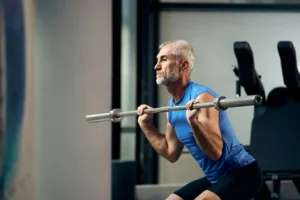If you’re here, you’re likely wondering why your shoulder aches when you lift your arm. Chances are, it’s bicep tendonitis. This post will unpack the symptoms, demystify treatment options, and highlight prevention techniques, helping you navigate your path to recovery with clarity and ease.
Key Takeaways
- Bicep tendonitis typically presents with pain in the front of the shoulder down to the elbow, limited movement, and tenderness in the upper arm, which are key signals indicating a problem with the biceps tendons.
- Repetitive movements, overuse, and certain sports can lead to the wear and tear of the biceps tendon, with rotator cuff disorders often being associated with bicep tendonitis, affecting shoulder stability and function.
- Treatment for bicep tendonitis ranges from rest and NSAIDs for mild cases to physical therapy and surgery for more severe cases, followed by rehabilitation to regain full range of motion while prevention strategies include warm-ups and posture adjustments.
Recognizing Bicep Tendonitis: Symptoms and Indicators
Have you ever lifted something heavy and felt a pain that radiates from your shoulder down to your elbow? That could be your body signaling bicep tendonitis. This ailment is marked by a distinct discomfort in the front of the shoulder and upper arm muscle, often limiting your ability to move freely. It can creep up on you, intensifying during movements such as lifting or bending your arm.
Weakness in the arm coupled with tenderness when you press on the area might also point towards this condition. When you visit an orthopedic surgeon, they’ll ask about these very symptoms—pain, weakness, and discomfort in the shoulder or upper arm—to pinpoint the diagnosis. It’s like your body’s way of saying, “Hey, something’s not right here,” and it’s essential to heed these warning signs.
The Role of Biceps Tendons in Shoulder Function
The biceps muscle, known for its role in flexing the elbow and rotating the forearm, relies on two critical tendons for its shoulder connection. The long head tendon, also known as the upper biceps tendon, is particularly vital, anchoring to the top of the shoulder socket and contributing as a passive stabilizer to shoulder dynamics, with the support of the tendon sheath. Think of it as a silent guardian, ensuring that every time you swing a golf club or reach out to grab something, your shoulder remains stable and moves smoothly.

This tendon isn’t just about stability—it plays a part in those nagging shoulder pains that are often linked with rotator cuff disorders. When the long head of the biceps tendon is overworked or injured, it can lead to discomfort, reminding us just how interconnected the parts of our shoulder truly are.
Factors Contributing to Bicep Tendonitis
The journey towards biceps tendinitis often begins with what we do every day. The wear and tear from age, overusing our arms, or repeating certain movements can set the stage for this condition. Athletes, take note: sports like baseball, tennis, and swimming are particularly notorious for inviting biceps tendinitis to the party. The long head of the biceps tendon is vulnerable due to its shoulder joint position, making it more prone to injury, including the risk of a biceps tendon rupture.
It’s not just about what you do, but also how you do it—mechanical factors such as repetitive traction and friction can contribute to that familiar anterior shoulder pain. And if you push through the pain and continue to overuse your biceps tendon, you’re flirting with danger, possibly leading to acute severe shoulder pain or even severe complications like tendon tears.
Rotator Cuff Disorders and Their Relationship with Bicep Tendonitis
Now, let’s delve a little deeper into the relationship between the biceps tendon and the rotator cuff, which is as intricate as a dance partnership. These two are often found in a tight embrace, with rotator cuff disorders frequently walking hand in hand with bicep tendonitis. If the rotator cuff tears, the long head of the biceps often inflames, further exacerbating bicep tendonitis.
The rotator cuff is like the body’s fine-tuned orchestra conductor, ensuring the upper arm bone stays within the shoulder socket and aiding in arm movement. But when the long head of the biceps tendon tears, it’s like losing a key musician, potentially disrupting the harmony of the shoulder and complicating its stability and function. This can sometimes lead to rotator cuff tendinitis, causing further discomfort in the upper arm.
Diagnosing Bicep Tendonitis: Physical Examination and Imaging Tests
When you suspect bicep tendonitis, your first stop is often an orthopedic surgeon’s office. Here, a blend of your medical history and a physical examination sets the stage for diagnosis. During the physical exam, the doctor will assess your range of motion, comparing the mobility of the affected arm with your other arm to identify discrepancies.
Imaging tests like X-rays, MRI, and ultrasound are the investigative tools that bring the hidden details of your biceps tendon and surrounding tissues to light. These tests are crucial because they can reveal the extent of the tendon’s involvement, ensuring that your treatment plan is tailored to your specific condition.
Non-Surgical Treatments for Bicep Tendonitis
For those who catch bicep tendonitis early, the road to recovery may not require a trip to the operating room. Home remedies and a pause from aggravating activities often do the trick. When it comes to medication, NSAIDs are the go-to for inflammation, while corticosteroid injections are reserved for more persistent cases. Remember, giving your arm the rest it needs is crucial; disregard this, and you might find yourself dealing with partial or full tendon tears.
Strengthening and Stretching Exercises
Once you’re on the mend, it’s time to gently coax your biceps tendon back into action with a series of strengthening and stretching exercises. These are crafted to ease symptoms and bolster shoulder function without overstepping the pain threshold. A repertoire of exercises including Vertical Shoulder Flexion, biceps curls, and various stretches will become your new allies in maintaining range of motion and muscle strength.
However, it’s important to navigate these exercises with care, avoiding any wrist turns that could provoke the pain associated with bicep tendonitis. The aim is to find that sweet spot where you’re nurturing your biceps tendon back to health without pushing it over the edge.
Surgical Interventions for Severe Cases
There are times when bicep tendonitis is like an uninvited guest who simply won’t leave. In such cases, surgical intervention may be the only way to show it the door. When conservative methods like medication and therapy fall short, procedures such as biceps tenotomy or tenodesis step into the spotlight.
These surgeries, which can include arthroscopy and repair, are all about giving your biceps tendon the structural support it needs to heal properly, as discussed in the j shoulder elbow surg journal.
Post-Surgery Rehabilitation and Recovery
Post-surgery, you’ll embark on a journey of rehabilitation, a delicate balance between protecting the repair site and regaining full range of motion. It often starts with wearing a sling, which is like a nest for your healing arm. The goal is to get you moving without pain, and for most patients, that’s a goal achieved after surgery for bicep tendonitis.
While recovery can be a triumph, it’s sometimes accompanied by a bitter pill—restrictions on high-demand overhead sports to safeguard against potential complications. It’s a trade-off worth considering for the greater good of long-term shoulder health.
Prevention Strategies for Bicep Tendonitis
Prevention is always better than cure, and when it comes to bicep tendonitis, a few simple strategies can keep you out of harm’s way. A proper warm-up can transform your muscles and tendons into supple, resilient fibers, ready to take on physical activities without buckling under pressure. Regular breaks are your best friend during repetitive tasks, giving your biceps muscle a much-needed breather.
Steering clear of repetitive overhead motion can significantly reduce the strain on your shoulder and biceps tendon. Good posture is like a protective bubble, keeping undue stress off your shoulder and arm. And when lifting heavy objects, think of hugging them close—this simple technique ensures an even load distribution and keeps your biceps muscle from crying foul.
Summary
As we wrap up our journey through the world of bicep tendonitis, it’s clear that understanding this condition is the first step toward conquering it. From recognizing the initial signs of pain and limited movement to exploring non-surgical treatments and the potential need for surgery, it’s all about listening to your body and responding with care. The recovery process, whether it involves rest and exercises or surgical intervention, paves the way to a stronger, more resilient arm.
Frequently Asked Questions
What are the 2 types of bicep tendonitis?
Bicep tendonitis can be categorized into two types: distal bicep tendonitis, which affects the tendon connecting the biceps to the elbow, and proximal bicep tendonitis, which impacts the tendon connecting the biceps to the shoulder.
What does bicep tendonitis feel like?
Bicep tendonitis can feel like pain or tenderness in the front of the shoulder, worsening with overhead activities, and may cause discomfort that moves down the upper arm bone. You might also experience an occasional snapping sound or sensation in the shoulder.
What is bicep tendonitis?
Bicep tendonitis is a condition that causes pain, tenderness, and limited range of motion in the front of the shoulder and upper arm, often due to overuse or injury to the biceps tendon.
Can bicep tendonitis heal on its own?
Yes, mild cases of bicep tendonitis can often heal on their own with rest, proper treatment and exercises, while severe cases may require surgery.
How long does it take to recover from bicep tendonitis?
Recovery time for bicep tendonitis varies based on severity. Non-surgical treatments may show improvement within a few weeks, while surgical recovery could take a few months for full function to return.





